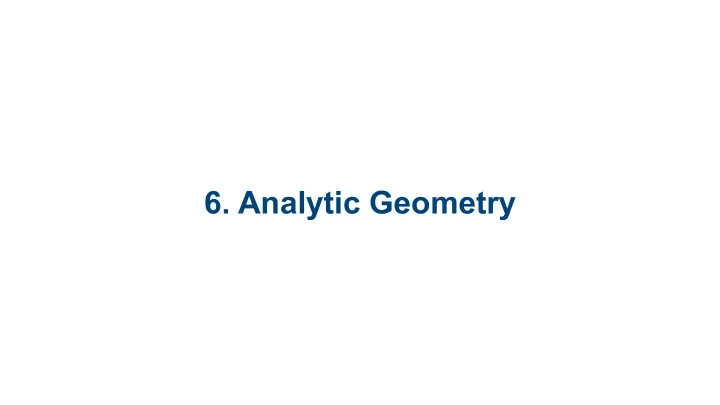

6. Analytic Geometry
6.1 Lines 6.2 Idea of Conic Sections 6.3 Circles 6.4 Ellipses 6.5 Parabolas 6.6 Hyperbolas
6.1 Lines
• The study of planar geometry goes back at least to Euclid (~300 BCE). • Lines are an important part of this theory. • Two lines are said to be parallel if they never intersect, or equivalently, if they have the same slope. • Two lines are said to be perpendicular if they intersect at a right angle.
Analysis of Slopes • Given formulae for two lines, one can quickly determine if they are parallel or perpendicular by analyzing their slopes: y = m 1 x + b 1 y = m 2 x + b 2 • The lines are parallel if m 1 = m 2 . m 1 = − 1 • The lines are perpendicular if . m 2
Determine if the following lines are parallel, perpendicular, or neither: • y=3x+1, y=3x-6 • y=3x+1, y=1/3x-2 • y=x+1, y=-x+2 • 3y=4-x, 2x=6-6y
6.2 Idea of Conic Sections
• Conic sections are curves derived from intersection a two-dimensional plane with a double-cone. • They include: circles, ellipses, parabolas, and hyperbolas. • Lines are also conic sections, but in a trivial and uninteresting way.
6.3 Circles
• Circles are sets of points that are at fixed distance to a center point. • The distance from points on the circle to this center is called the radius of the circle. • Circles do not fit into the polygon regime, because circles do not have edges per se. • They may be though of as having infinitely many edges in a certain sense, which can be made precise with calculus.
( x − a ) 2 + ( y − b ) 2 = r 2 ( a, b ) is the center of the circle r is the radius of the circle
Area and Circumference of Circles • The area of a circle is given in terms of its radius: Area = π r 2 • The length of the circle is typically called circumference rather than perimeter , and may be computed as C = 2 π r • One may also easily discuss the circumference in terms of diameter of the circle. The diameter is the length of a line going across the circle and through the center.
• Hence, the diameter of a circle has length equal to twice that of the radius: D = 2 r • With this, we see that the circumference may also be computed in terms of diameter as C = π D
Find the area and circumference of the following circles: • r = 3 • d = 10
Arcs in a Circle • One can discuss inscribed angles in a circle, and the corresponding arc length they cut off. • The size of the angle is proportional to the length of the arc: Length Arc = Angle 360 . C • A similar principle holds for wedge areas: Area Wedge Area Circle = Angle 360 .
Find the area of the following circular arcs: • r = 5, theta = 90 • arc length = 10, theta = 30
6.4 Ellipses
• Ellipses generalize circles. • They are stretched in some direction, making them more oblong. ( x − a ) 2 + ( y − b ) 2 = 1 c 2 d 2 • is the center of the ellipse ( a, b ) • determine how the ellipse is stretched. c, d
Plot x 2 4 + y 2 9 = 1
Plot ( x + 1) 2 + ( y − 1) 2 = 1 16
Area of an Ellipse ( x − a ) 2 + ( y − b ) 2 = 1 c 2 d 2 Area = π cd
Compute the area of ( x − 1) 2 + ( y − 2) 2 = 1 4 25
Foci of an Ellipse • Ellipses may be understood as being a set of points a fixed distance from two points. • These points are called foci, and may be computed from the formula defining the ellipse.
( x − a ) 2 + ( y − b ) 2 = 1 c 2 d 2 p c 2 − d 2 , b ) if c > d Foci =( a ± p d 2 − c 2 ) if c ≤ d =( a, b ±
Plot and find the foci of ( x − 1) 2 + ( y − 2) 2 = 1 16 25
6.5 Parabolas
• Parabolas are curves that define points whose distance to a fixed line and a fixed point are the same. • This line is called the directrix , and the point is called the focus. • The general form for a parabola is y = 4 px 2 or x = 4 py 2 • Here, specifies the directrix and the focus. p
Plot x = 8 y 2
Plot the parabola with directrix y = − 2 and focus (0 , 2)
6.6 Hyperbolas
• Hyperbolas look very much like ellipses in their formula. • They are visually very different when plotted. ( x − a ) 2 − ( y − b ) 2 = 1 c 2 d 2 • is the center. ( a, b ) • determine the shape of the hyperbola. c, d
Plot x 2 − y 2 = 1
• Hyperbolas have asymptotes that ± d have slope c • The hyperbola pieces tend to, but never reach, these asymptotes. • They can be useful for sketching.
Plot ( x + 2) 2 − y 2 = 1 9
Recommend
More recommend